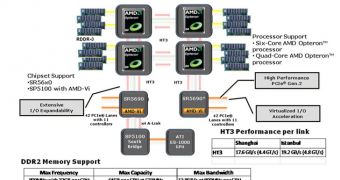Sunnyvale, California-based Advanced Micro Devices has announced today the launch of its new server platform, designed specifically to enable customers to take full advantage of the chip maker's latest generation of six-core Opteron processors, formerly codenamed 'Istanbul'. The new chipset series is part of the company's Fiorano platform and includes three different models, which, according to AMD, should enable customers to benefit from the features delivered by a unified processor and chipset technology that delivers performance and energy efficiency.
“Our focus is to deliver on the aspects of a server platform that directly impact the IT manager – improved performance on key workloads and virtualization, and low overall power consumption,” said Patrick Patla, vice president and general manager, Server and Embedded Business, AMD. “This new platform and the platform specification codenamed 'Kroner' allow our OEM customers to deliver unique solutions to solve a particular datacenter problem. And they can recognize development and time to market value because of the consistency and commonality across our product generations.”
As mentioned before, AMD's new product announcement concerns three different chipsets, namely the SR5690, SR5670 and SR5650 I/O hubs, which will be paired with the SP5100 southbridge and provide motherboard and server makers with a wider choice for new motherboards. Unfortunately, AMD hasn't released the specific details regarding the differences between the three new chipsets, but, according to available details, the SR5650 will apparently be aimed at low-power servers.
Said chipset will be paired with the company's Highly Efficient (HE) and Extremely Efficient (EE) Opteron processors, which are specified at 55 watts and 40 watts, respectively, a considerable reduction from the 75 watts specified for standard parts. As for the SR5690, paired with the SP5100 southbridge, this solution is said to be capable of scaling to a maximum of eight processor sockets, but it remains to be seen whether motherboard makers will choose to go down this path.

 14 DAY TRIAL //
14 DAY TRIAL //